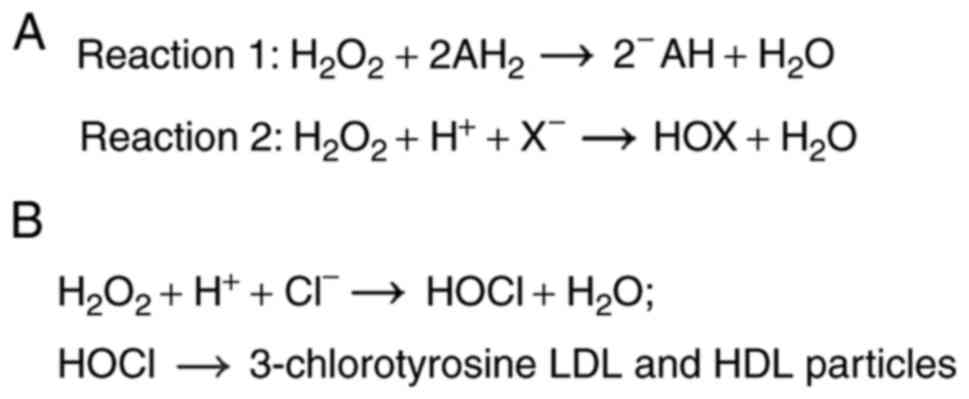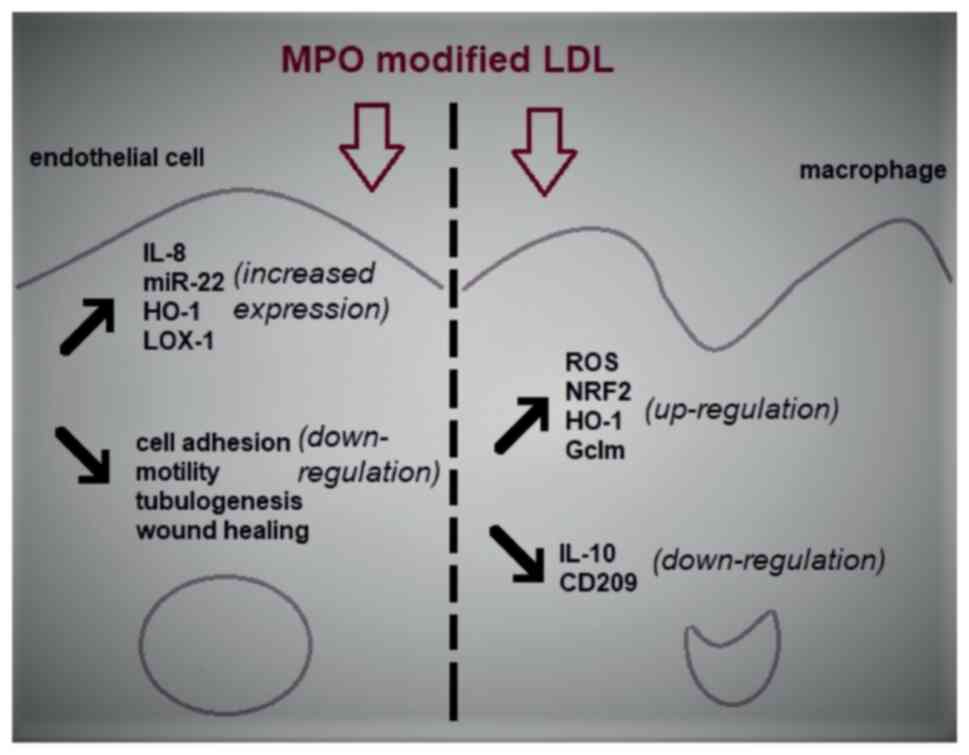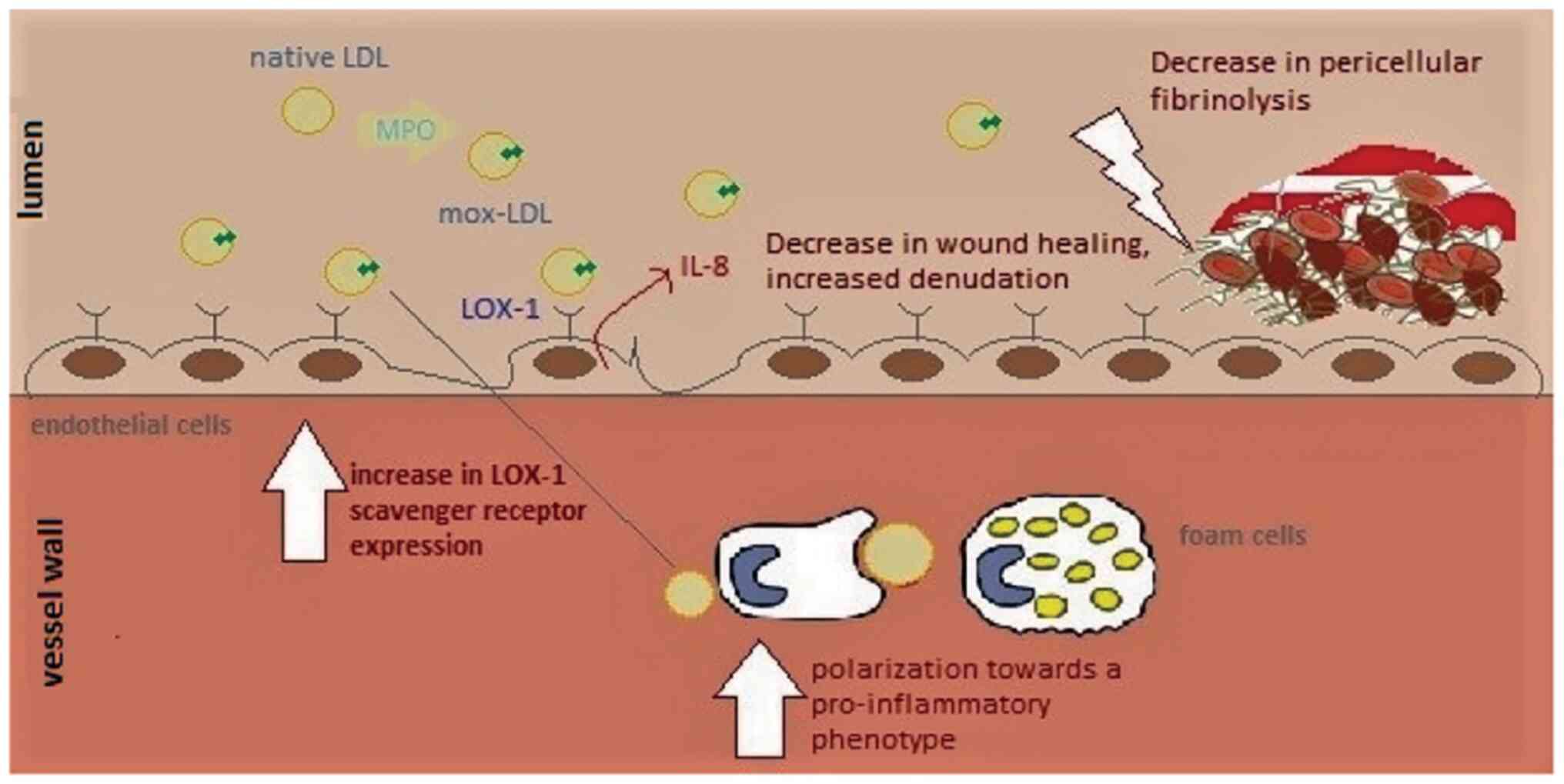|
1
|
Zamocky M, Jakopitsch C, Furtmüller PG,
Dunand C and Obinger C: The peroxidase-cyclooxygenase superfamily:
Reconstructed evolution of critical enzymes of the innate immune
system. Proteins. 72:589–605. 2008.PubMed/NCBI View Article : Google Scholar
|
|
2
|
Arnhold J: The dual role of
myeloperoxidase in immune response. Int J Mol Sci.
21(8057)2020.PubMed/NCBI View Article : Google Scholar
|
|
3
|
Aratani Y: Myeloperoxidase: Its role for
host defense, inflammation, and neutrophil function. Arch Biochem
Biophys. 640:47–52. 2018.PubMed/NCBI View Article : Google Scholar
|
|
4
|
Daugherty A, Dunn JL, Rateri DL and
Heinecke JW: Myeloperoxidase, a catalyst for lipoprotein oxidation,
is expressed in human atherosclerotic lesions. J Clin Invest.
94:437–444. 1994.PubMed/NCBI View Article : Google Scholar
|
|
5
|
Malle E, Waeg G, Schreiber R, Gröne EF,
Sattler W and Gröne HJ: Immunohistochemical evidence for the
myeloperoxidase/H2O2/halide system in human
atherosclerotic lesions: Colocalization of myeloperoxidase and
hypochlorite-modified proteins. Eur J Biochem. 267:4495–4503.
2000.PubMed/NCBI View Article : Google Scholar
|
|
6
|
Teng N, Maghzal GJ, Talib J, Rashid I, Lau
AK and Stocker R: The roles of myeloperoxidase in coronary artery
disease and its potential implication in plaque rupture. Redox Rep.
22:51–73. 2017.PubMed/NCBI View Article : Google Scholar
|
|
7
|
Daher J: Other forms of oxidized LDL:
Emerging functions (Review). World Acad Sci J. 2(4)2020.
|
|
8
|
Zámocký M, Hofbauer S, Schaffner I,
Gasselhuber B, Nicolussi A, Soudi M, Pirker KF, Furtmüller PG and
Obinger C: Independent evolution of four heme peroxidase
superfamilies. Arch Biochem Biophys. 574:108–119. 2015.PubMed/NCBI View Article : Google Scholar
|
|
9
|
Vanhamme L, Zouaoui Boudjeltia K, Van
Antwerpen P and Delporte C: The other myeloperoxidase: Emerging
functions. Arch Biochem Biophys. 649:1–14. 2018.PubMed/NCBI View Article : Google Scholar
|
|
10
|
Delporte C, Van Antwerpen P, Vanhamme L,
Roumeguère T and Zouaoui Boudjeltia K: Low-density lipoprotein
modified by myeloperoxidase in inflammatory pathways and clinical
studies. Mediators Inflamm. 2013(971579)2013.PubMed/NCBI View Article : Google Scholar
|
|
11
|
van der Veen BS, de Winther MP and
Heeringa P: Myeloperoxidase: Molecular mechanisms of action and
their relevance to human health and disease. Antioxid Redox Signal.
11:2899–2937. 2009.PubMed/NCBI View Article : Google Scholar
|
|
12
|
Hansson M, Olsson I and Nauseef WM:
Biosynthesis, processing, and sorting of human myeloperoxidase.
Arch Biochem Biophys. 445:214–224. 2006.PubMed/NCBI View Article : Google Scholar
|
|
13
|
Malle E, Furtmüller PG, Sattler W and
Obinger C: Myeloperoxidase: A target for new drug development? Br J
Pharmacol. 152:838–854. 2007.PubMed/NCBI View Article : Google Scholar
|
|
14
|
Sugiyama S, Okada Y, Sukhova GK, Virmani
R, Heinecke JW and Libby P: Macrophage myeloperoxidase regulation
by granulocyte macrophage colony-stimulating factor in human
atherosclerosis and implications in acute coronary syndromes. Am J
Pathol. 158:879–891. 2001.PubMed/NCBI View Article : Google Scholar
|
|
15
|
Schindhelm RK, van der Zwan LP, Teerlink T
and Scheffer PG: Myeloperoxidase: A useful biomarker for
cardiovascular disease risk stratification? Clin Chem.
55:1462–1470. 2009.PubMed/NCBI View Article : Google Scholar
|
|
16
|
Smith JD: Dysfunctional HDL as a
diagnostic and therapeutic target. Arterioscler Thromb Vasc Biol.
30:151–155. 2010.PubMed/NCBI View Article : Google Scholar
|
|
17
|
Hazen SL and Heinecke JW:
3-Chlorotyrosine, a specific marker of myeloperoxidase-catalyzed
oxidation, is markedly elevated in low density lipoprotein isolated
from human atherosclerotic intima. J Clin Invest. 99:2075–2081.
1997.PubMed/NCBI View Article : Google Scholar
|
|
18
|
Pennathur S, Bergt C, Shao B, Byun J,
Kassim SY, Singh P, Green PS, McDonald TO, Brunzell J, Chait A, et
al: Human atherosclerotic intima and blood of patients with
established coronary artery disease contain high density
lipoprotein damaged by reactive nitrogen species. J Biol Chem.
279:42977–42983. 2004.PubMed/NCBI View Article : Google Scholar
|
|
19
|
Zheng L, Nukuna B, Brennan ML, Sun M,
Goormastic M, Settle M, Schmitt D, Fu X, Thomson L, Fox PL, et al:
Apolipoprotein A-I is a selective target for
myeloperoxidase-catalyzed oxidation and functional impairment in
subjects with cardiovascular disease. J Clin Invest. 114:529–541.
2004.PubMed/NCBI View Article : Google Scholar
|
|
20
|
Bergt C, Pennathur S, Fu X, Byun J,
O'Brien K, McDonald TO, Singh P, Anantharamaiah GM, Chait A,
Brunzell J, et al: The myeloperoxidase product hypochlorous acid
oxidizes HDL in the human artery wall and impairs ABCA1-dependent
cholesterol transport. Proc Natl Acad Sci USA. 101:13032–13037.
2004.PubMed/NCBI View Article : Google Scholar
|
|
21
|
Nussbaum C, Klinke A, Adam M, Baldus S and
Sperandio M: Myeloperoxidase: A leukocyte-derived protagonist of
inflammation and cardiovascular disease. Antioxid Redox Signal.
18:692–713. 2013.PubMed/NCBI View Article : Google Scholar
|
|
22
|
Yang J, Ji R, Cheng Y, Sun JZ, Jennings LK
and Zhang C: L-arginine chlorination results in the formation of a
nonselective nitric-oxide synthase inhibitor. J Pharmacol Exp Ther.
318:1044–1049. 2006.PubMed/NCBI View Article : Google Scholar
|
|
23
|
Zhang C, Reiter C, Eiserich JP, Boersma B,
Parks DA, Beckman JS, Barnes S, Kirk M, Baldus S, Darley-Usmar VM
and White CR: L-arginine chlorination products inhibit endothelial
nitric oxide production. J Biol Chem. 276:27159–27165.
2001.PubMed/NCBI View Article : Google Scholar
|
|
24
|
Stocker R, Huang A, Jeranian E, Hou JY, Wu
TT, Thomas SR and Keaney JF Jr: Hypochlorous acid impairs
endothelium-derived nitric oxide bioactivity through a
superoxide-dependent mechanism. Arterioscler Thromb Vasc Biol.
24:2028–2033. 2004.PubMed/NCBI View Article : Google Scholar
|
|
25
|
Gimbrone MA Jr and García-Cardeña G:
Endothelial cell dysfunction and the pathobiology of
atherosclerosis. Circ Res. 118:620–636. 2006.PubMed/NCBI View Article : Google Scholar
|
|
26
|
Vita JA, Brennan ML, Gokce N, Mann SA,
Goormastic M, Shishehbor MH, Penn MS, Keaney JF Jr and Hazen SL:
Serum myeloperoxidase levels independently predict endothelial
dysfunction in humans. Circulation. 110:1134–1139. 2004.PubMed/NCBI View Article : Google Scholar
|
|
27
|
Fu X, Kassim SY, Parks WC and Heinecke JW:
Hypochlorous acid oxygenates the cysteine switch domain of
pro-matrilysin (MMP-7). A mechanism for matrix metalloproteinase
activation and atherosclerotic plaque rupture by myeloperoxidase. J
Biol Chem. 276:41279–41287. 2001.PubMed/NCBI View Article : Google Scholar
|
|
28
|
Wang Y, Rosen H, Madtes DK, Shao B, Martin
TR, Heinecke JW and Fu X: Myeloperoxidase inactivates TIMP-1 by
oxidizing its N-terminal cysteine residue: An oxidative mechanism
for regulating proteolysis during inflammation. J Biol Chem.
282:31826–31834. 2007.PubMed/NCBI View Article : Google Scholar
|
|
29
|
Klebanoff SJ, Kinsella MG and Wight TN:
Degradation of endothelial cell matrix heparan sulfate proteoglycan
by elastase and the myeloperoxidase-H2O2-chloride system. Am J
Pathol. 143:907–917. 1993.PubMed/NCBI
|
|
30
|
Zhang R, Brennan ML, Fu X, Aviles RJ,
Pearce GL, Penn MS, Topol EJ, Sprecher DL and Hazen SL: Association
between myeloperoxidase levels and risk of coronary artery disease.
JAMA. 286:2136–2142. 2001.PubMed/NCBI View Article : Google Scholar
|
|
31
|
Nikpoor B, Turecki G, Fournier C, Théroux
P and Rouleau GA: A functional myeloperoxidase polymorphic variant
is associated with coronary artery disease in French-Canadians. Am
Heart J. 142:336–339. 2001.PubMed/NCBI View Article : Google Scholar
|
|
32
|
Kutter D, Devaquet P, Vanderstocken G,
Paulus JM, Marchal V and Gothot A: Consequences of total and
subtotal myeloperoxidase deficiency: Risk or benefit? Acta
Haematol. 104:10–15. 2000.PubMed/NCBI View Article : Google Scholar
|
|
33
|
Nicholls SJ and Hazen SL: Myeloperoxidase
and cardiovascular disease. Arterioscler Thromb Vasc Biol.
25:1102–1111. 2005.PubMed/NCBI View Article : Google Scholar
|
|
34
|
Heslop CL, Frohlich JJ and Hill JS:
Myeloperoxidase and C-reactive protein have combined utility for
long-term prediction of cardiovascular mortality after coronary
angiography. J Am Coll Cardiol. 55:1102–1109. 2010.PubMed/NCBI View Article : Google Scholar
|
|
35
|
Bentzon JF, Otsuka F, Virmani R and Falk
E: Mechanisms of plaque formation and rupture. Circ Res.
114:1852–1866. 2014.PubMed/NCBI View Article : Google Scholar
|
|
36
|
Delporte C, Boudjeltia KZ, Noyon C,
Furtmüller PG, Nuyens V, Slomianny MC, Madhoun P, Desmet JM, Raynal
P, Dufour D, et al: Impact of myeloperoxidase-LDL interactions on
enzyme activity and subsequent posttranslational oxidative
modifications of apoB-100. J Lipid Res. 55:747–757. 2014.PubMed/NCBI View Article : Google Scholar
|
|
37
|
Yoshida H, Quehenberger O, Kondratenko N,
Green S and Steinberg D: Minimally oxidized low-density lipoprotein
increases expression of scavenger receptor A, CD36, and macrosialin
in resident mouse peritoneal macrophages. Arterioscler Thromb Vasc
Biol. 18:794–802. 1998.PubMed/NCBI View Article : Google Scholar
|
|
38
|
Steinberg D: Low density lipoprotein
oxidation and its pathobiological significance. J Biol Chem.
272:20963–20966. 1997.PubMed/NCBI View Article : Google Scholar
|
|
39
|
Mehta JL, Chen J, Hermonat PL, Romeo F and
Novelli G: Lectin-like, oxidized low-density lipoprotein receptor-1
(LOX-1): A critical player in the development of atherosclerosis
and related disorders. Cardiovasc Res. 69:36–45. 2006.PubMed/NCBI View Article : Google Scholar
|
|
40
|
Gao S, Zhao D, Wang M, Zhao F, Han X, Qi Y
and Liu J: GW28-e0393 Association between circulating oxidized
low-density lipoprotein and atherosclerotic cardiovascular disease:
A meta-analysis of prospective observational studies. J Am Coll
Cardiol. 70 (16 Suppl):C79–C80. 2017.PubMed/NCBI View Article : Google Scholar
|
|
41
|
Holvoet P, Mertens A, Verhamme P, Bogaerts
K, Beyens G, Verhaeghe R, Collen D, Muls E and Van de Werf F:
Circulating oxidized LDL is a useful marker for identifying
patients with coronary artery disease. Arterioscler Thromb Vasc
Biol. 21:844–848. 2001.PubMed/NCBI View Article : Google Scholar
|
|
42
|
Kita T, Kume N, Minami M, Hayashida K,
Murayama T, Sano H, Moriwaki H, Kataoka H, Nishi E, Horiuchi H, et
al: Role of oxidized LDL in atherosclerosis. Ann N Y Acad Sci.
947:199–206. 2001.PubMed/NCBI View Article : Google Scholar
|
|
43
|
Mitra S, Goyal T and Mehta JL: Oxidized
LDL, LOX-1 and atherosclerosis. Cardiovasc Drugs Ther. 25:419–429.
2011.PubMed/NCBI View Article : Google Scholar
|
|
44
|
Yoshida H and Kisugi R: Mechanisms of LDL
oxidation. Clin Chim Acta. 411:1875–1882. 2010.PubMed/NCBI View Article : Google Scholar
|
|
45
|
Carr AC: Hypochlorous acid-modified
low-density lipoprotein inactivates the lysosomal protease
cathepsin B: Protection by ascorbic and lipoic acids. Redox Rep.
6:343–349. 2001.PubMed/NCBI View Article : Google Scholar
|
|
46
|
Sokolov AV, Chekanov AV, Kostevich VA,
Aksenov DV, Vasilyev VB and Panasenko OM: Revealing binding sites
for myeloperoxidase on the surface of human low density
lipoproteins. Chem Phys Lipids. 164:49–53. 2011.PubMed/NCBI View Article : Google Scholar
|
|
47
|
Moguilevsky N, Zouaoui Boudjeltia K, Babar
S, Delrée P, Legssyer I, Carpentier Y, Vanhaeverbeek M and Ducobu
J: Monoclonal antibodies against LDL progressively oxidized by
myeloperoxidase react with ApoB-100 protein moiety and human
atherosclerotic lesions. Biochem Biophys Res Commun. 323:1223–1228.
2004.PubMed/NCBI View Article : Google Scholar
|
|
48
|
Vaes M, Zouaoui Boudjeltia KZ, Van
Antwerpen P, Babar S, Deger F, Neve J, Vanhaeverbeek M and Ducobu
J: ThP15:146 Low-density lipoprotein oxidation by myeloperoxidase
occurs in the blood circulation during hemodialysis.
Atherosclerosis Suppl. 7(525)2006.
|
|
49
|
Zouaoui Boudjeltia K, Daher J, Van
Antwerpen P, Moguilevsky N, Delree P, Ducobu J, Raes M, Badran B,
Vanhaeverbeek M, Brohee D, et al: Exposure of endothelial cells to
physiological levels of myeloperoxidase-modified LDL delays
pericellular fibrinolysis. PLoS One. 7(e38810)2012.PubMed/NCBI View Article : Google Scholar
|
|
50
|
Podrez EA, Schmitt D, Hoff HF and Hazen
SL: Myeloperoxidase-generated reactive nitrogen species convert LDL
into an atherogenic form in vitro. J Clin Invest. 103:1547–1560.
1999.PubMed/NCBI View Article : Google Scholar
|
|
51
|
Leeuwenburgh C, Hardy MM, Hazen SL, Wagner
P, Oh-ishi S, Steinbrecher UP and Heinecke JW: Reactive nitrogen
intermediates promote low density lipoprotein oxidation in human
atherosclerotic intima. J Biol Chem. 272:1433–1436. 1997.PubMed/NCBI View Article : Google Scholar
|
|
52
|
Wang Z, Nicholls SJ, Rodriguez ER, Kummu
O, Hörkkö S, Barnard J, Reynolds WF, Topol EJ, DiDonato JA and
Hazen SL: Protein carbamylation links inflammation, smoking, uremia
and atherogenesis. Nat Med. 13:1176–1184. 2007.PubMed/NCBI View Article : Google Scholar
|
|
53
|
Nicholson AC, Frieda S, Pearce A and
Silverstein RL: Oxidized LDL binds to CD36 on human
monocyte-derived macrophages and transfected cell lines. Evidence
implicating the lipid moiety of the lipoprotein as the binding
site. Arterioscler Thromb Vasc Biol. 15:269–275. 1995.PubMed/NCBI View Article : Google Scholar
|
|
54
|
Isa SA, Ruffino JS, Ahluwalia M, Thomas
AW, Morris K and Webb R: M2 macrophages exhibit higher sensitivity
to oxLDL-induced lipotoxicity than other monocyte/macrophage
subtypes. Lipids Health Dis. 10(229)2011.PubMed/NCBI View Article : Google Scholar
|
|
55
|
Montano EN, Boullier A, Almazan F, Binder
CJ, Witztum JL and Hartvigsen K: Development and application of a
nonradioactive binding assay of oxidized low-density lipoprotein to
macrophage scavenger receptors. J Lipid Res. 54:3206–3214.
2013.PubMed/NCBI View Article : Google Scholar
|
|
56
|
Houben T, Oligschlaeger Y, Bitorina AV,
Hendrikx T, Walenbergh SMA, Lenders MH, Gijbels MJJ, Verheyen F,
Lütjohann D, Hofker MH, et al: Blood-derived macrophages prone to
accumulate lysosomal lipids trigger oxLDL-dependent murine hepatic
inflammation. Sci Rep. 7(12550)2017.PubMed/NCBI View Article : Google Scholar
|
|
57
|
Westendorf T, Graessler J and Kopprasch S:
Hypochlorite-oxidized low-density lipoprotein upregulates CD36 and
PPARgamma mRNA expression and modulates SR-BI gene expression in
murine macrophages. Mol Cell Biochem. 277:143–152. 2005.PubMed/NCBI View Article : Google Scholar
|
|
58
|
Woenckhaus C, Kaufmann A, Bussfeld D,
Gemsa D, Sprenger H and Gröne HJ: Hypochlorite-modified LDL:
Chemotactic potential and chemokine induction in human monocytes.
Clin Immunol Immunopathol. 86:27–33. 1998.PubMed/NCBI View Article : Google Scholar
|
|
59
|
Vicca S, Hennequin C, Nguyen-Khoa T, Massy
ZA, Descamps-Latscha B, Drüeke TB and Lacour B: Caspase-dependent
apoptosis in THP-1 cells exposed to oxidized low-density
lipoproteins. Biochem Biophys Res Commun. 273:948–954.
2000.PubMed/NCBI View Article : Google Scholar
|
|
60
|
Marsche G, Zimmermann R, Horiuchi S,
Tandon NN, Sattler W and Malle E: Class B scavenger receptors CD36
and SR-BI are receptors for hypochlorite-modified low density
lipoprotein. J Biol Chem. 278:47562–47570. 2003.PubMed/NCBI View Article : Google Scholar
|
|
61
|
Boudjeltia KZ, Legssyer I, Van Antwerpen
P, Kisoka RL, Babar S, Moguilevsky N, Delree P, Ducobu J, Remacle
C, Vanhaeverbeek M and Brohee D: Triggering of inflammatory
response by myeloperoxidase-oxidized LDL. Biochem Cell Biol.
84:805–812. 2006.PubMed/NCBI View Article : Google Scholar
|
|
62
|
Calay D, Rousseau A, Mattart L, Nuyens V,
Delporte C, Van Antwerpen P, Moguilevsky N, Arnould T, Boudjeltia
KZ and Raes M: Copper and myeloperoxidase-modified LDLs activate
Nrf2 through different pathways of ROS production in macrophages.
Antioxid Redox Signal. 13:1491–1502. 2010.PubMed/NCBI View Article : Google Scholar
|
|
63
|
Vlaminck B, Calay D, Genin M, Sauvage A,
Ninane N, Zouaoui Boudjeltia K, Raes M and Michiels C: Effects of
copper sulfate-oxidized or myeloperoxidase-modified LDL on lipid
loading and programmed cell death in macrophages under hypoxia.
Hypoxia (Auckl). 2:153–169. 2014.PubMed/NCBI View Article : Google Scholar
|
|
64
|
Bazzi S, Frangie C, Azar E and Daher J:
The effect of myeloperoxidase-oxidized LDL on THP-1 macrophage
polarization and repolarization. Innate Immun. 28(2):91–103.
2022.PubMed/NCBI View Article : Google Scholar
|
|
65
|
Daher J, Martin M, Rousseau A, Nuyens V,
Fayyad-Kazan H, Van Antwerpen P, Courbebaisse G, Martiat P, Badran
B, Dequiedt F, et al: Myeloperoxidase oxidized LDL interferes with
endothelial cell motility through miR-22 and heme oxygenase 1
induction: Possible involvement in reendothelialization of vascular
injuries. Mediators Inflamm. 2014(134635)2014.PubMed/NCBI View Article : Google Scholar
|
|
66
|
El Samad G, Bazzi S, Karam M, Boudjeltia
KZ, Vanhamme L and Daher J: Effect of myeloperoxidase modified LDL
on bovine and human aortic endothelial cells. Exp Ther Med.
18:4567–4574. 2019.PubMed/NCBI View Article : Google Scholar
|
|
67
|
Neri Serneri GG, Coppo M, Bandinelli M,
Paoletti P, Toscano T, Micalizzi E, Chiostri M and Boddi M:
Exaggerated myocardial oxLDL amount and LOX-1 receptor
over-expression associated with coronary microvessel inflammation
in unstable angina. Atherosclerosis. 226:476–482. 2013.PubMed/NCBI View Article : Google Scholar
|
|
68
|
Porubsky S, Schmid H, Bonrouhi M, Kretzler
M, Malle E, Nelson PJ and Gröne HJ: Influence of native and
hypochlorite-modified low-density lipoprotein on gene expression in
human proximal tubular epithelium. Am J Pathol. 164:2175–2187.
2004.PubMed/NCBI View Article : Google Scholar
|
|
69
|
El-Hajjar L, Hindieh J, Andraos R,
El-Sabban M and Daher J: Myeloperoxidase-oxidized LDL activates
human aortic endothelial cells through the LOX-1 scavenger
receptor. Int J Mol Sci. 23(2837)2002.PubMed/NCBI View Article : Google Scholar
|

















